
Barbara Stanwyck was an American actress, model and dancer. A stage, film, and television star, during her 60-year professional career she was known for her strong, realistic screen presence and versatility. She was a favorite of directors, including Cecil B. DeMille, Fritz Lang, and Frank Capra, and made 85 films in 38 years before turning to television.

Bringing Up Baby is a 1938 American screwball comedy film directed by Howard Hawks, and starring Katharine Hepburn and Cary Grant. It was released by RKO Radio Pictures. The film tells the story of a paleontologist in a number of predicaments involving a scatterbrained heiress and a leopard named Baby. The screenplay was adapted by Dudley Nichols and Hagar Wilde from a short story by Wilde which originally appeared in Collier's Weekly magazine on April 10, 1937.

The Pride of the Yankees is a 1942 American sports drama film produced by Samuel Goldwyn, directed by Sam Wood, and starring Gary Cooper, Teresa Wright, and Walter Brennan. It is a tribute to the legendary New York Yankees first baseman Lou Gehrig, who died a year before its release, at age 37, from amyotrophic lateral sclerosis, which later became known to the lay public as "Lou Gehrig's disease".
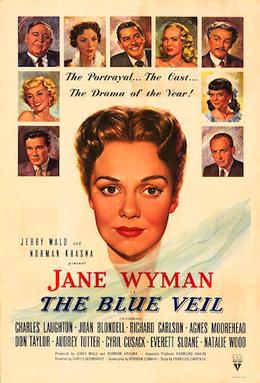
The Blue Veil is a 1951 American historical drama film directed by Curtis Bernhardt and starring Jane Wyman, Charles Laughton and Joan Blondell. It tells the story of a woman who spends her life caring for other people’s children, beginning just after World War I. The title refers to the headdresses once worn by governesses and nannies, colored blue to distinguish them from the white veils worn by medical nurses. The screenplay by Norman Corwin is based on a story by François Campaux, adapted for the French-language film Le Voile Bleu in 1942.

The Long Night is a 1947 American film noir crime-drama directed by Anatole Litvak and produced by RKO Pictures. It is a remake of Le jour se lève (1939) by Marcel Carné. The drama stars Henry Fonda, Barbara Bel Geddes, Vincent Price and Ann Dvorak. The title of the original French film is an idiom which translates roughly as "dawn is breaking".
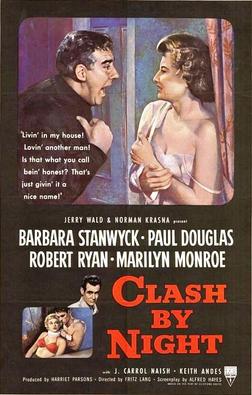
Clash by Night is a 1952 American film noir drama directed by Fritz Lang and starring Barbara Stanwyck, Paul Douglas, Robert Ryan, Marilyn Monroe and Keith Andes. The film is based on the 1941 play by Clifford Odets, adapted for the screen by writer Alfred Hayes. It is the first major film to credit Monroe before the title, albeit with fourth billing.

In film theory, the "Hawksian woman" is a character archetype of the tough-talking woman, popularized in film by director Howard Hawks through his use of actresses such as Katharine Hepburn, Ann Dvorak, Rosalind Russell, Barbara Stanwyck, and Angie Dickinson. The best known Hawksian woman is probably Lauren Bacall, who iconically played the type opposite Humphrey Bogart in To Have and Have Not and The Big Sleep. The archetype was first identified by film critic Naomi Wise in 1971.
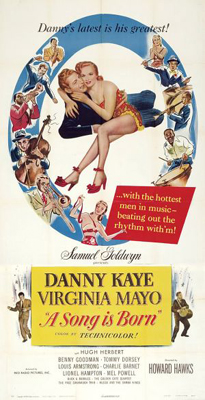
A Song Is Born, starring Danny Kaye and Virginia Mayo, is a 1948 Technicolor musical film remake of Howard Hawks' 1941 movie Ball of Fire with Gary Cooper and Barbara Stanwyck. This version was also directed by Hawks, based on the story "From A to Z" by Billy Wilder and Thomas Monroe, adapted by Harry Tugend (uncredited) and produced by Samuel Goldwyn and released by RKO Radio Pictures.

Barbara Stanwyck was a prolific American actress and dancer who appeared in a total of 95 theatrically released full-length motion pictures. Orphaned before she was old enough to attend school, she became fascinated by the burgeoning film industry, and actress Pearl White in particular, whom she would mimic on the playgrounds. "Pearl White was my goddess, and her courage, her grace, and her triumphs lifted me out of this world."

Annie Oakley is a 1935 American Western film directed by George Stevens and starring Barbara Stanwyck, Preston Foster, Melvyn Douglas and Moroni Olsen. The film is based on the life of Annie Oakley.

The Mad Miss Manton is a 1938 American screwball comedy-mystery film directed by Leigh Jason and starring Barbara Stanwyck as fun-loving socialite Melsa Manton and Henry Fonda as newspaper editor Peter Ames. Melsa and her debutante friends hunt for a murderer while eating bonbons, flirting with Ames, and otherwise behaving like irresponsible socialites. Ames is also after the murderer, as well as Melsa's hand in marriage.

Walk on the Wild Side is a 1962 American drama film directed by Edward Dmytryk, and starring Laurence Harvey, Capucine, Jane Fonda, Anne Baxter and Barbara Stanwyck. It was adapted from the 1956 novel A Walk on the Wild Side by American author Nelson Algren. The film was scripted by John Fante.

Beauty for the Asking is a 1939 film drama produced by RKO Pictures, and starring Lucille Ball and Patric Knowles.
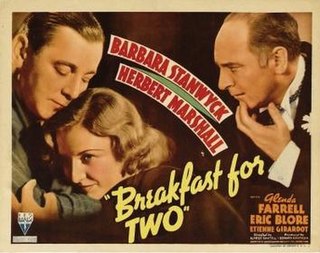
Breakfast for Two is a 1937 American screwball comedy film directed by Alfred Santell and starring Barbara Stanwyck, Herbert Marshall and Glenda Farrell. The film was produced and distributed by RKO Pictures, but was a commercial failure for the studio. Stanwyck and Marshall worked together once more, immediately following this film, on the 20th Century-Fox drama Always Goodbye (1938).

The Plough and the Stars is a 1937 American drama film directed by John Ford and starring Barbara Stanwyck and Preston Foster. It is based on the play of the same name written by Seán O'Casey.

Blowing Wild is a 1953 American Western film directed by Hugo Fregonese starring Gary Cooper, Barbara Stanwyck, and Anthony Quinn. It was written by Philip Yordan. The story revolves around a love triangle set in the oilfields of an unnamed South American country plagued with bandits. Ruth Roman also stars and adds to the romantic entanglements.

This Is My Affair is a 1937 American period crime film directed by William A. Seiter and starring Robert Taylor, Barbara Stanwyck, Victor McLaglen and Brian Donlevy. It was produced and released by 20th Century Fox.

My Life with Caroline is a 1941 American comedy film directed by Lewis Milestone and starring Ronald Colman and Anna Lee, in her second Hollywood film and her first in a starring role. The supporting cast featured Charles Winninger, Reginald Gardiner and Gilbert Roland. The screenplay was written by John Van Druten and Arnold Belgard.

RKO Radio Pictures Inc., commonly known as RKO Pictures or simply RKO, was an American film production and distribution company, one of the "Big Five" film studios of Hollywood's Golden Age. The business was formed after the Keith-Albee-Orpheum theater chain and Joseph P. Kennedy's Film Booking Offices of America studio were brought together under the control of the Radio Corporation of America (RCA) in October 1928. RCA executive David Sarnoff engineered the merger to create a market for the company's sound-on-film technology, RCA Photophone, and in early 1929 production began under the RKO name. Two years later, another Kennedy concern, the Pathé studio, was folded into the operation. By the mid-1940s, RKO was controlled by investor Floyd Odlum.
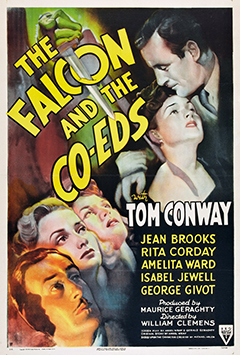
The Falcon and the Co-eds is a 1943 film under the direction of William Clemens, and produced by Maurice Geraghty, the same team that had worked on The Falcon in Danger (1943) and would stay together for the next film in the Falcon series. The Falcon and the Co-eds was the seventh of 16 in the Falcon series. The story and screenplay was by Ardel Wray, a frequent collaborator with Val Lewton in his RKO horror series, who added supernatural elements to the proceedings.






















